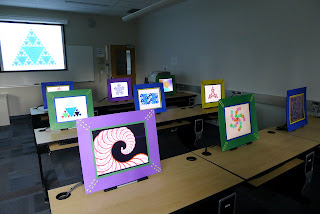 |
| How to create a Curve Stitch Design |
There is an interesting article in Maths Plus about the relationship between these Curve Stitches and Bezier Curves: http://plus.maths.org/content/bridges-string-art-and-bezier-curves
Jason Davies also has a nice animation illustrating how Bezier curves are formed..
There are many very nice examples of String Art on the web. One of my favourite sites is by Lionel Deimel (
http://www.deimel.org/rec_math/cube.htm). Lionel has experimented with computer programs to create some very detailed examples and he gives a very thorough explanation of how he created the images.
There is also a Pinterest board with some lovely examples (mostly made with string): http://pinterest.com/bonkaperry/art-string-art
Here are some ideas for creating Curve Stitches of your own.
Approach 1: Graph paper
The easiest way to start is with a ruler, a pencil and some graph paper. Draw a few lines, mark divisions on the lines and connect them. Any easy way to play around with the divisions is to measure the length of the line, divide it in half and place a mark. Do the same with the line you want to connect to and join the two marks together. Next take the two smaller line segments you have created on the first line and divide them in half. Repeat for the line you are connecting to. Join the marks (make sure you match up the right ones!). You can do this over and over again until you have the number of divisions that you think looks nice or you get tired. Make sure your pencil is sharp!
You can also create String Art with string and cardboard as shown by Wen Jin Chow:
http://wchow.home.znet.com/SquareArt.htm
Approach 2: Scratch
You can use the Pen and Motion blocks in Scratch or BYOB to create computer String Art designs.
I used a BYOB program to create the picture below:
 |
| Screen Shot of Output from BYOB program |
I recommend that you try mapping out the design on graph paper first, assign coordinates to the ends of the lines and then create the design in Scratch or BYOB. Once you have created a design in BYOB, you can play around with different things like pen colour, pen size, the number of times you divide the line and the placement of the original lines.
If you don't feel like writing your own program, you can use the following Scratch program to create String Art on the computer: http://scratch.mit.edu/projects/Paddle2See/50076
Just click to make three dots and the program will fill in the lines for you. Keep clicking to extend your design.
Approach 3: Inkscape Path Effect
The one drawback of Scratch and BYOB is that the canvas for drawing is pretty small and the lines are not very fine. If you want more precision, you might try a Scalable Vector Graphics tool like Inkscape.
There are at least two ways to create Curve Stitches with Inkscape. The first is to use the built in Path Effect tool. To do this, draw two lines using the Pen tool. Select the two lines and from the top menu bar select Path -> Combine:
 |
| Step 1 |
Next, from the top menu bar select Path - > Path Effect Editor...
 |
| Step 2 |
Finally, in the Path Effect Editor, choose "Stitch Sub-paths" from the "Add new effect " drop down and click on the "Add" button.
 |
| Step 3 |
You should now see lines drawn between the two original lines. You can adjust the number of lines that are drawn using the "Number of paths" field.
 |
| Step 4 |
 |
| Curve Stitch Circular Design based on Deimel's design |
Approach 4: Inkscape Extension
If you want to be more precise, you can use Inkscape Extensions and a write a python script to generate the lines. I used the pTurtle class which provides a nice turtle graphics style API and created a simple Inkscape extension. To try it out, copy the following two files:
curve_stitch_1.inx
curve_stitch_1.py
and placed them in the "C:\Program Files (x86)\Inkscape\share\extensions" (or wherever your Inkscape extensions folder may be). Then in Inkscape select "Extensions -> My Math Art Examples -> Curve Stitch 1..." This extension was used to generate the picture below which is based on Deimel's Isometric Cube design:
 |
| Curve Stitch Isometric Cube design based on Deimel's design |




































